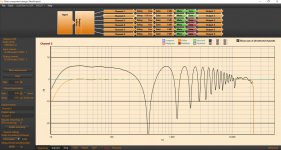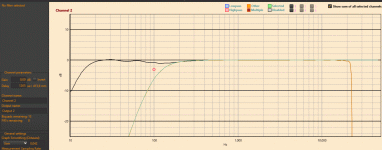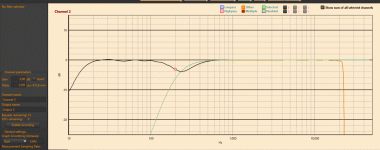Hi,
I haven't been posting on diyAudio for a long time...
Got yesterday 2 FusionAmps FA123 which I intend using for the upper baffle of 4-way LX521 dipoles.
Up to now, I used either a 3-way ASP, or a nanoDigi8 DSP, or Acourate and AcourateConvolver.
So I have been digging into HFD for a few hours (4.8 and latest firmware).
2 questions :
1. impulse response import of a pulse recorded with Acourate needs to be imported in REW first and then re-exported in a text format for HFD. But HFD seems to refuse the file header containing the reference level, so I need to set the gain at -115dB or more to see the curve on HFD, that is way away from the near 0dB XO curves. Is there a way to avoid this ?
2. technically, looking at the plate and PCBs, it should be possible to use the amps without the DSP/DAC. Did someone try it ? any idea of the ribbon cables connectors pinout between DSP and amps (not even speaking of the electrical caracteristics of the amp inputs) ?
Francois
I haven't been posting on diyAudio for a long time...
Got yesterday 2 FusionAmps FA123 which I intend using for the upper baffle of 4-way LX521 dipoles.
Up to now, I used either a 3-way ASP, or a nanoDigi8 DSP, or Acourate and AcourateConvolver.
So I have been digging into HFD for a few hours (4.8 and latest firmware).
2 questions :
1. impulse response import of a pulse recorded with Acourate needs to be imported in REW first and then re-exported in a text format for HFD. But HFD seems to refuse the file header containing the reference level, so I need to set the gain at -115dB or more to see the curve on HFD, that is way away from the near 0dB XO curves. Is there a way to avoid this ?
2. technically, looking at the plate and PCBs, it should be possible to use the amps without the DSP/DAC. Did someone try it ? any idea of the ribbon cables connectors pinout between DSP and amps (not even speaking of the electrical caracteristics of the amp inputs) ?
Francois
any idea of the ribbon cables connectors pinout between DSP and amps (not even speaking of the electrical caracteristics of the amp inputs) ?
Francois
Check the documentation of the NC122MP and NC100HF amplifiers at Hypex.nl.
Hi all,
My Fusion plate amp I had set up for testing was working fine yesterday, now when I turn it on, it cycles through the settings and then none of the lights come on, no audio through the optical.
I have only micro USB cables at the workshop, so will take home and see if HFD shows anything and try another input. Seems strange for the settings to change.
Has anyone else had a similar problem, I'm hoping its a quick easy fix in settings.
My Fusion plate amp I had set up for testing was working fine yesterday, now when I turn it on, it cycles through the settings and then none of the lights come on, no audio through the optical.
I have only micro USB cables at the workshop, so will take home and see if HFD shows anything and try another input. Seems strange for the settings to change.
Has anyone else had a similar problem, I'm hoping its a quick easy fix in settings.
ds23man,
mmmh, I did not think of possible DSP delays (though used to them with the software filtering...), very good remark / question ! I could delay the woofers as well, on their Tact amps.
mspijker,
good idea for the pinout.
As my measurements were already done with Acourate, I simply wanted to avoid repeating them, mostly by lazyness...
Thank you !
mmmh, I did not think of possible DSP delays (though used to them with the software filtering...), very good remark / question ! I could delay the woofers as well, on their Tact amps.
mspijker,
good idea for the pinout.
As my measurements were already done with Acourate, I simply wanted to avoid repeating them, mostly by lazyness...
Thank you !
Hi all,
My Fusion plate amp I had set up for testing was working fine yesterday, now when I turn it on, it cycles through the settings and then none of the lights come on, no audio through the optical.
I have only micro USB cables at the workshop, so will take home and see if HFD shows anything and try another input. Seems strange for the settings to change.
Has anyone else had a similar problem, I'm hoping its a quick easy fix in settings.
Contact Hypex, it's broken.
One question, how do you solve the latency problem between the upper 3 ways and your low channnel? The fusion dsp will ad an extra 1.2 ms delay.
There is no "latency problem".....
Crossover frequency of LX521 woofer section is 120 Hz.
That's 287 cm wavelength at the crossover frequency.
A delay of 1.2 ms means some 35 cm "offset". At 120 Hz that is about 45 degrees phase and proportionally less at lower frequencies, so it can be ignored.
DSP is a nice tool, but it does not mean that creating good sounding loudspeakers has become easier, at least not as long as this kind of nonsense pops up.
Last edited:
There is no "latency problem".....
Crossover frequency of LX521 woofer section is 120 Hz.
That's 287 cm wavelength at the crossover frequency.
A delay of 1.2 ms means some 0.35 cm "offset"at 120 Hz and proportionally less at lower frequencies, so it can be ignored.
DSP is a nice tool, but it does not mean that creating good sounding loudspeakers has become easier, at least not as long as this kind of nonsense pops up.
Maybe you missed the concept of the speed of sound, but 1.2ms delay is 35cm at 100Hz and at 20Khz....
Hi,
2. technically, looking at the plate and PCBs, it should be possible to use the amps without the DSP/DAC. Did someone try it ? any idea of the ribbon cables connectors pinout between DSP and amps (not even speaking of the electrical caracteristics of the amp inputs) ?
Francois
I have been thinking likewise: there is a connector that has line level. So that can be intercepted.
I was thinking of an attenuator right there. For instance with an optical potentiometer (NSL-32SR2. - Optocoupler, Photocell / LDR Output) that can be managed centrally for all channels.
Requirements: a daughter board with an input pin header, the LDR-pot(s), an output ribbon with the same connector and layout as the orriginal cable.
and this is how it should work: J4.1-2 and J4.13-14 intercepted, and all others passed on straight (two way). Assuming the attenuation quality is indeed 'perfectly' fit.
You are right with the numbers; I edited.
Nevertheless, at these low frequencies the phase "error" will be 45 degrees or less, which is not important with respect to the character of low frequency sound propagation in a room.
To be frank, you can't ignore this. A simulation of two drivers delayed with 1.2 ms:
The main dip is at 400Hz but starts already below 100Hz.
Attachments
I don't see any issues up to the frequency the LX521 woofer is supposed to work (120 Hz LR4).
Woofer output will about zero at 400 Hz.
Your model is a typical example of a (freefield?) simulation; real behavior will be different and largely room dependent.
An example: Two ideal flat drivers crossed at 100 and 200Hz LR4 with the upper driver delayed 1.2 mS
Attachments
mspijker, triode_al
the documentation of the NC122MP and NC100HF is exactly what I need... these amps seem to be the ones used on the Fusion. Thank you for the link.
so the input impedance is 47k, balanced or not, and the sensitivity easy to calculate. I probably won't use a pot for level adjustment.
A question might arise, concerning the assessment : "Time delay to signal, from moment all power supplies are within operational limits" = 1500ms. I hope this is the "first signal delay" and not a permanent one...
the documentation of the NC122MP and NC100HF is exactly what I need... these amps seem to be the ones used on the Fusion. Thank you for the link.
so the input impedance is 47k, balanced or not, and the sensitivity easy to calculate. I probably won't use a pot for level adjustment.
A question might arise, concerning the assessment : "Time delay to signal, from moment all power supplies are within operational limits" = 1500ms. I hope this is the "first signal delay" and not a permanent one...
An example: Two ideal flat drivers crossed at 100 and 200Hz LR4 with the upper driver delayed 1.2 mS
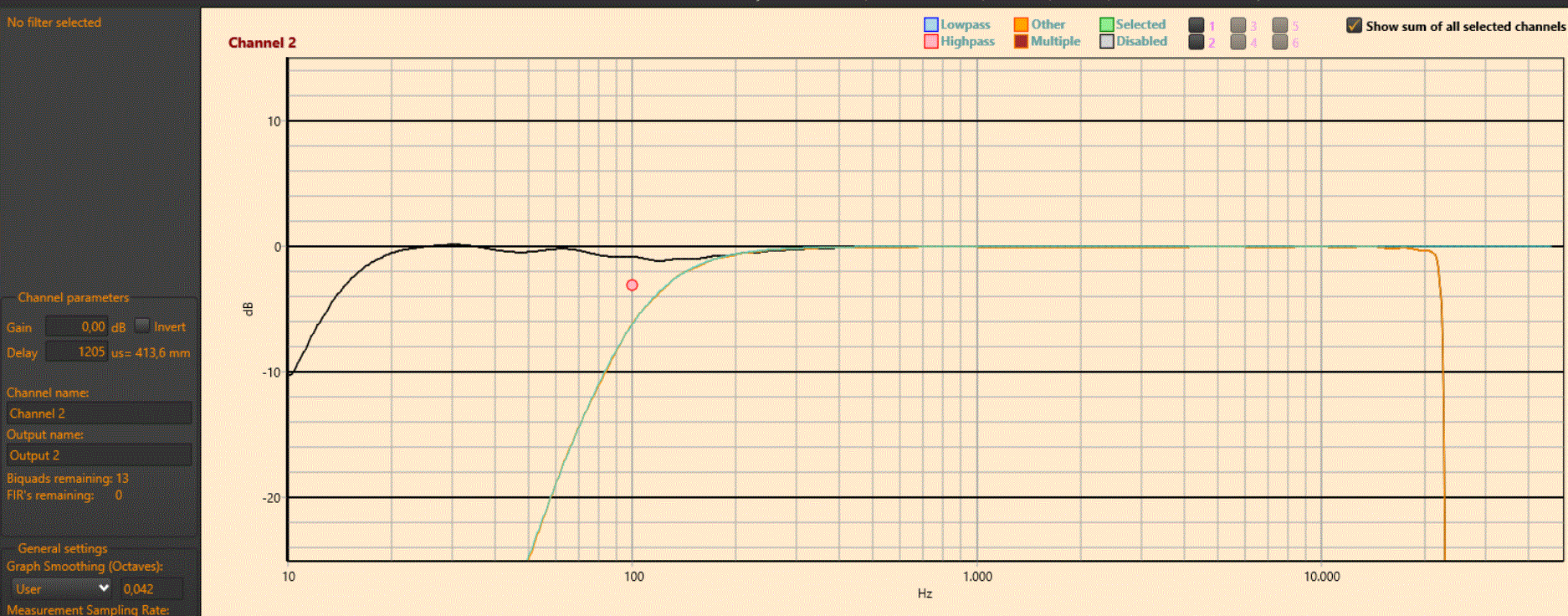
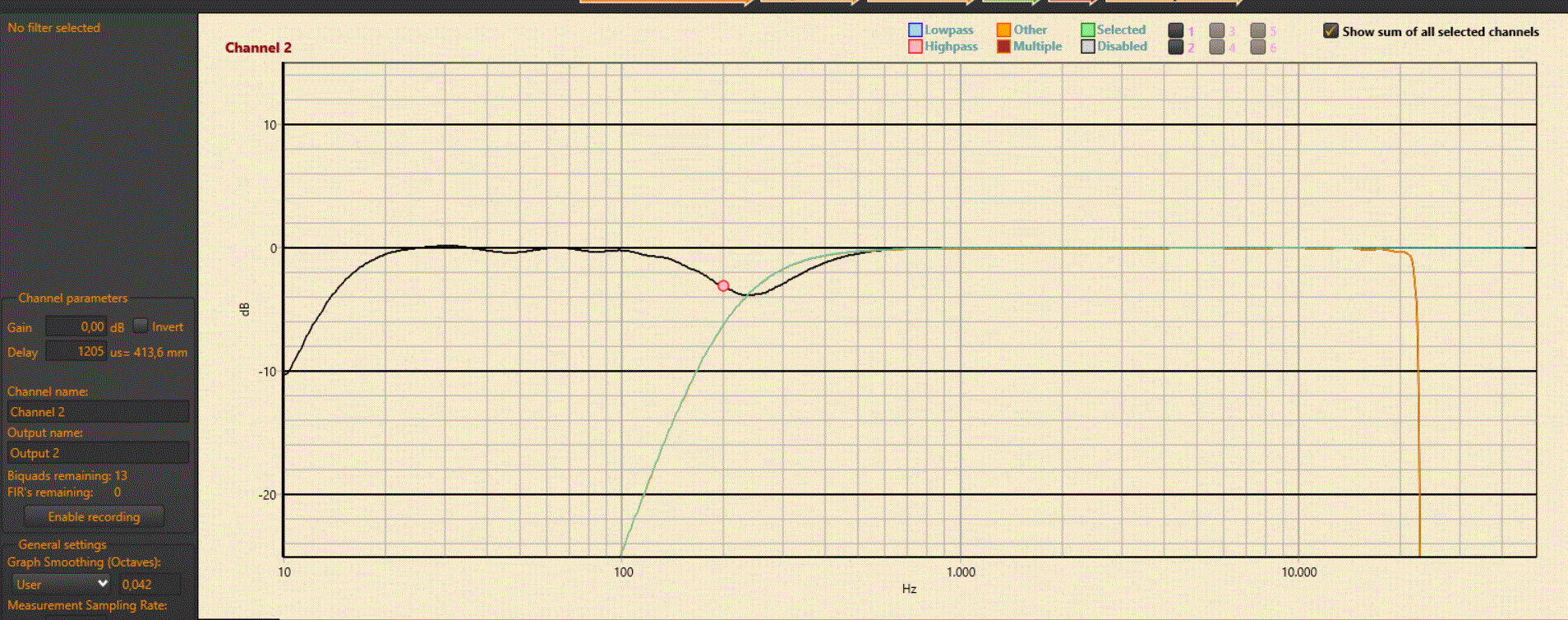
Again: freefield "ideal" model?
I suggest to read about the audibility of group delay in loudspeakers.
This is a start with good references:
Discussion of Group Delay in Loudspeakers
Your presumptions are based on modelling which is so easy with today's software and DSP; however, to create good loudspeakers these are mere tools.
To get the best results they are not sufficient.
Interesting link about delay.
As far as the LX521 are concerned, the delays used in DSP or IIR are all below 1ms, medium or even tweeter to woofers (don't ask me for accurate figures, they should likely not be disclosed, though the last setups work without added delays)
Despite this, I do definitely hear a difference with and without them. Something I could describe as sound coherence. The test can be considered as A-B as it takes around 2 seconds to switch between the setups.
Of course this is a subjective opinion... and not the thread subject !
As far as the LX521 are concerned, the delays used in DSP or IIR are all below 1ms, medium or even tweeter to woofers (don't ask me for accurate figures, they should likely not be disclosed, though the last setups work without added delays)
Despite this, I do definitely hear a difference with and without them. Something I could describe as sound coherence. The test can be considered as A-B as it takes around 2 seconds to switch between the setups.
Of course this is a subjective opinion... and not the thread subject !
My simulation examples have nothing to do with group delay. Driver offsets can cause a dip at the xover point. In a setup with only a dsp at the upper channels this will result in a woofer moved forward. With a 1.2mS latency in the dsp this is 41 cm + the front to voice coil offset. At very low x-over points it's not a big issue but in the given example it will be starting at 200Hz and is worst at 400Hz.
It is just plain, simple physics:
A LR xover will sum flat if the drivers have a flat responce up and below the xover point AND do not have an offset in time.
It is just plain, simple physics:
A LR xover will sum flat if the drivers have a flat responce up and below the xover point AND do not have an offset in time.
- Home
- Amplifiers
- Class D
- The New Hypex Fusion Plate amps
